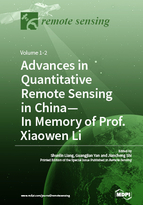Advances in Quantitative Remote Sensing in China – In Memory of Prof. Xiaowen Li
A special issue of Remote Sensing (ISSN 2072-4292).
Deadline for manuscript submissions: closed (7 January 2018) | Viewed by 227349
Special Issue Editors
Interests: quantitative land remote sensing; Earth’s energy budget; global environmental change
Special Issues, Collections and Topics in MDPI journals
Interests: multiangular remote sensing; vegetation remote sensing; radiation budget
Interests: microwave remote sensing of water cycle related components
Special Issue Information
Dear Colleagues,
China has recently developed a very comprehensive and ambitious Earth observation program. Hundreds of satellites have been launched or will be lunched soon. A series of grand research projects have been funded to process and analyze the huge amount of satellite data. As a result, significant progress in quantitative remote sensing has been made from radiative transfer modeling, advanced inversion methods, high-level products generation, to various applications.
In memory of Prof. Xiaowen Li, who was one of the pioneers in promoting quantitative remote sensing study in China, we organized the third national forum on quantitative remote sensing in Beijing Normal University, July 14 and 15, 2017. More than 200 people attended this forum.
To document the progress and facilitate more international collaborations, we propose to edit this Special Issue on Remote Sensing.
It will cover the full aspects of quantitative remote sensing, with particular focus on:
- New satellite missions
- Radiative transfer modeling
- Inversion methodology
- Satellite products generation
- Field measurements and validation
- Satellite product applications
In addition to regular submissions, some review papers will be invited. We will also write an Editorial to summarize the achievements of Prof. Xiaowen Li as a memorial.
Thank you for your consideration.
Dr. Shunlin LiangDr. Guangjian Yan
Dr. Jiancheng Shi
Guest Editors
Manuscript Submission Information
Manuscripts should be submitted online at www.mdpi.com by registering and logging in to this website. Once you are registered, click here to go to the submission form. Manuscripts can be submitted until the deadline. All submissions that pass pre-check are peer-reviewed. Accepted papers will be published continuously in the journal (as soon as accepted) and will be listed together on the special issue website. Research articles, review articles as well as short communications are invited. For planned papers, a title and short abstract (about 100 words) can be sent to the Editorial Office for announcement on this website.
Submitted manuscripts should not have been published previously, nor be under consideration for publication elsewhere (except conference proceedings papers). All manuscripts are thoroughly refereed through a single-blind peer-review process. A guide for authors and other relevant information for submission of manuscripts is available on the Instructions for Authors page. Remote Sensing is an international peer-reviewed open access semimonthly journal published by MDPI.
Please visit the Instructions for Authors page before submitting a manuscript. The Article Processing Charge (APC) for publication in this open access journal is 2700 CHF (Swiss Francs). Submitted papers should be well formatted and use good English. Authors may use MDPI's English editing service prior to publication or during author revisions.






